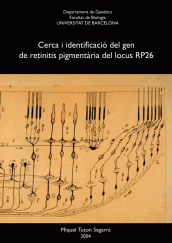thesis
Cerca i identificació del gen de retinitis pigmentària autosòmica recessiva del locus RP26
Author: Miquel Tuson Segarra
Supervisors: Roser Gonzàlez-Duarte i Gemma Marfany Nadal
Universitat de Barcelona, 24 de novembre de 2004
[link] [pdf0] [pdf1] [pdf2] [pdf3] [pdf4] [pdf5] [pdf6]
Author: Miquel Tuson Segarra
Supervisors: Roser Gonzàlez-Duarte i Gemma Marfany Nadal
Universitat de Barcelona, 24 de novembre de 2004
[link] [pdf0] [pdf1] [pdf2] [pdf3] [pdf4] [pdf5] [pdf6]

Retinitis Pigmentosa (RP), the main cause of adult blindness, is a genetically heterogeneous disorder characterized by the progressive loss of photoreceptor cells through apoptosis. Up to now, 32 genes have been implicated in RP.
The main goal of my PhD thesis was the search of a novel autosomal recessive RP gene within the RP26 locus. This locus had been identified by linkage analysis on 2q31.2-q32.3. As no obvious positional candidates were found among known genes, an expressed sequence tag (EST) database search was undertaken to identify sequences expressed in the retina. Following this approach, we characterized a novel gene within the RP26 locus, ORMDL1. This gene belongs to a eukaryotic gene family that encode highly conserved endoplasmic reticulum transmembrane proteins.
In the second part of the thesis, we refined the RP26 locus down to 2.5 Mb by homozygosity mapping. After unsuccessful mutational analysis of the nine genes initially reported in this region, a detailed gene search based on expressed-sequence-tag data was undertaken. We finally identified a novel gene encoding a ceramide kinase (CERKL), which encompassed 13 exons. All of the patients from the RP26 family bear a homozygous mutation in exon 5, which generates a premature termination codon. The same mutation was also characterized in another, unrelated, Spanish pedigree with arRP. Human CERKL is expressed in the retina, among other adult and fetal tissues. A more detailed analysis by in situ hybridization on adult murine retina sections showed expression of Cerkl in the ganglion cell layer. Ceramide kinases convert the sphingolipid metabolite ceramide into ceramide-1-phosphate, both key mediators of cellular apoptosis and survival. Ceramide metabolism plays an essential role in the viability of neuronal cells, the membranes of which are particularly rich in sphingolipids. Therefore, CERKL deficiency could shift the relative levels of the signaling sphingolipid metabolites and increase sensitivity of photoreceptor and other retinal cells to apoptotic stimuli. This was the first genetic report suggesting a direct link between retinal neurodegeneration in RP and sphingolipid-mediated apoptosis.
The main goal of my PhD thesis was the search of a novel autosomal recessive RP gene within the RP26 locus. This locus had been identified by linkage analysis on 2q31.2-q32.3. As no obvious positional candidates were found among known genes, an expressed sequence tag (EST) database search was undertaken to identify sequences expressed in the retina. Following this approach, we characterized a novel gene within the RP26 locus, ORMDL1. This gene belongs to a eukaryotic gene family that encode highly conserved endoplasmic reticulum transmembrane proteins.
In the second part of the thesis, we refined the RP26 locus down to 2.5 Mb by homozygosity mapping. After unsuccessful mutational analysis of the nine genes initially reported in this region, a detailed gene search based on expressed-sequence-tag data was undertaken. We finally identified a novel gene encoding a ceramide kinase (CERKL), which encompassed 13 exons. All of the patients from the RP26 family bear a homozygous mutation in exon 5, which generates a premature termination codon. The same mutation was also characterized in another, unrelated, Spanish pedigree with arRP. Human CERKL is expressed in the retina, among other adult and fetal tissues. A more detailed analysis by in situ hybridization on adult murine retina sections showed expression of Cerkl in the ganglion cell layer. Ceramide kinases convert the sphingolipid metabolite ceramide into ceramide-1-phosphate, both key mediators of cellular apoptosis and survival. Ceramide metabolism plays an essential role in the viability of neuronal cells, the membranes of which are particularly rich in sphingolipids. Therefore, CERKL deficiency could shift the relative levels of the signaling sphingolipid metabolites and increase sensitivity of photoreceptor and other retinal cells to apoptotic stimuli. This was the first genetic report suggesting a direct link between retinal neurodegeneration in RP and sphingolipid-mediated apoptosis.
